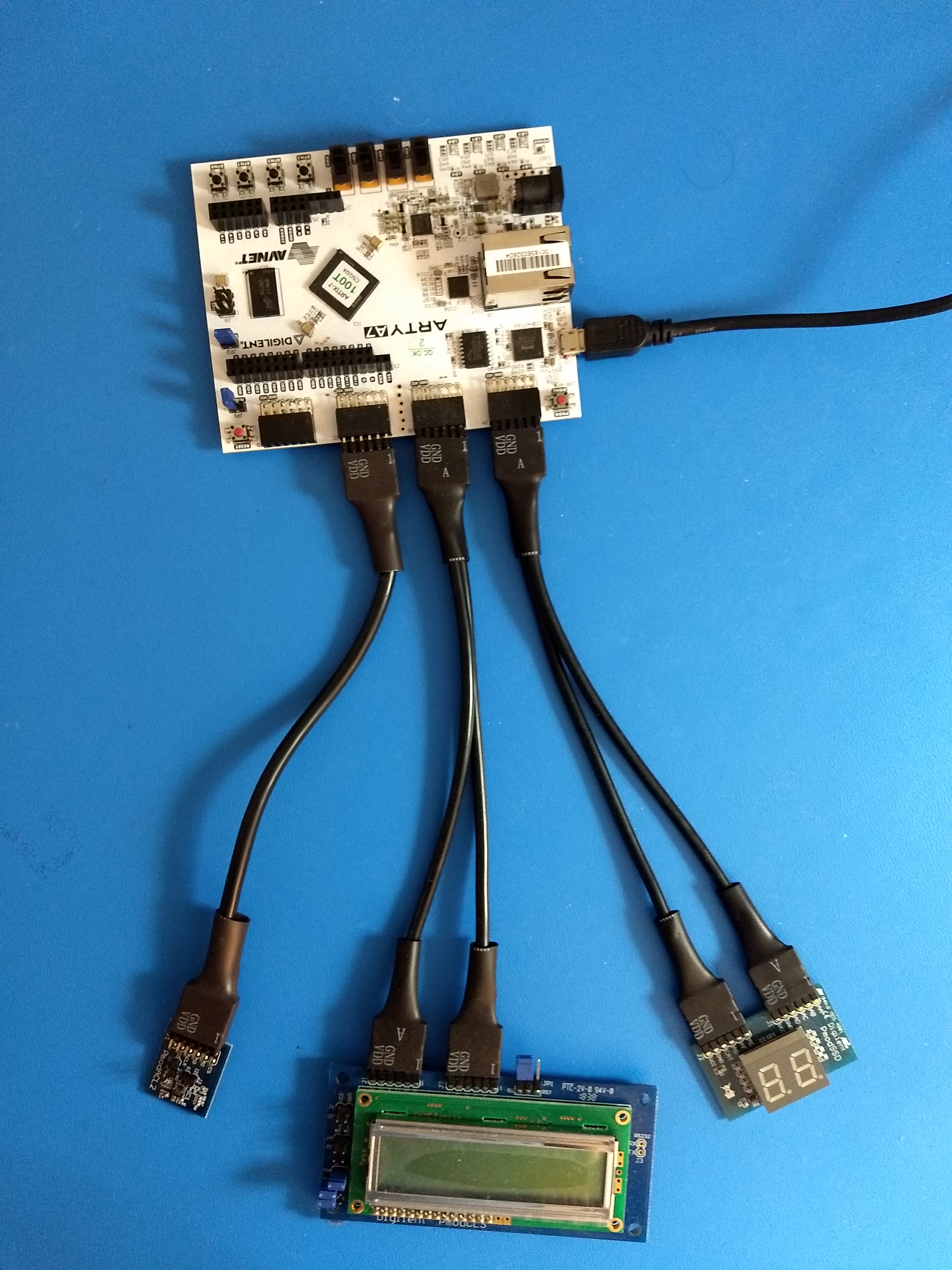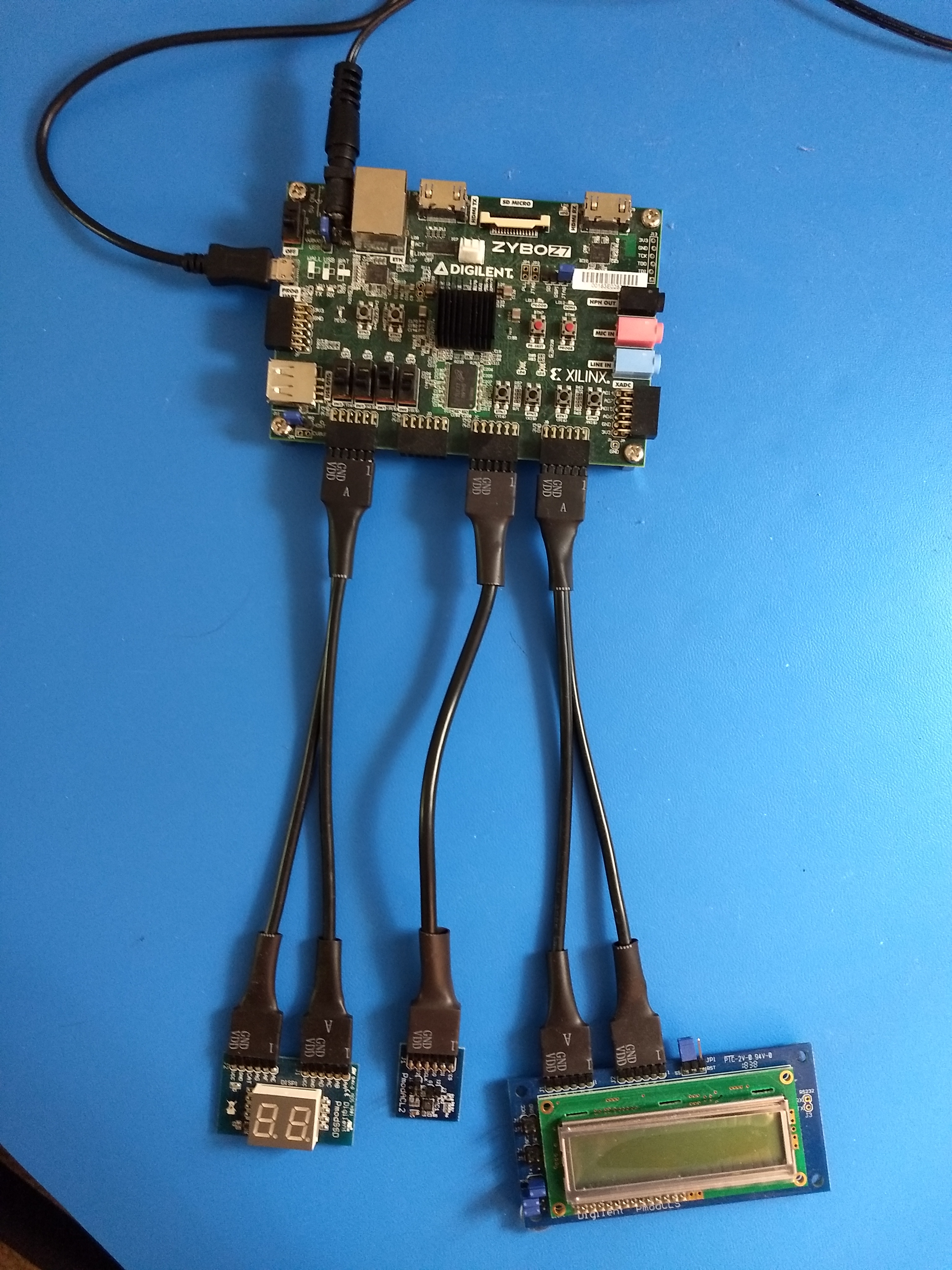Refresh of the FPGA Accelerometer Tester
fpga-serial-acl-tester-3
FPGA Serial ACL Tester Version 3
by Timothy Stotts
FPGA Serial ACL Tester Version 3 project and source code
Description
A small FPGA project of different implementations for testing Measurement and Activity Events of a SPI accelerometer. The Xilinx MicroBlaze design and the three HDL designs targets the Digilent Inc. Arty-A7-100 FPGA development board containing a Xilinx Artix-7 FPGA. Three peripherals are used: Digilent Inc. Pmod ACL2, Digilent Inc. Pmod CLS., Digilent Inc. Pmod SSD. The Xilinx Zynq design targets the Digilent Inc. Zybo-Z7-20 FPGA development board containing a Xilinx Zynq-7000 APSoC. Three peripherals are used: Digilent Inc. Pmod ACL2, Digilent Inc. Pmod CLS., Digilent Inc. Pmod SSD.
The design is broken into five groupings. The first four groups target the Digilent Inc. Arty-A7-100 development board. The last group targets the Digilent Inc. Zybo-Z7-20 development board. The projects are likely portable to the smaller Arty-A7-35 and Zybo-Z7-10 respectively as the designs are low resource utilization.
The folder ACL-Tester-Design-MB contains a Xilinx Vivado IP Integrator plus Xilinx Vitis design. A microblaze soft CPU is instantiated to talk with board components, an accelerometer peripheral, a 16x2 character LCD peripheral, and a two-digit Seven Segment Display. Sources to be incorporated into a Xilinx Vitis project contain a very small FreeRTOS program in C; drivers for the peripherals, a real-time task to operate and poll the accelerometer, two real-time tasks to display data, and a real-time task to color-mix RGB LEDs. (None of the real-time tasks demonstrate executing with a precise timer, but only demonstrate a best-effort execution; as such, calling these tasks real-time may be a misnomer. Executing these tasks with a precise timer can be achieved with FreeRTOS; but the benefit does not outweigh the added complexity for this specific implementation.)
The folder ACL-Tester-Design-SV contains a Xilinx Vivado project with sources containing only SystemVerilog RTL modules. Plain HDL without a soft CPU or C code is authored to talk with board components, an accelerometer peripheral, and a 16x2 character LCD peripheral. The project uses clock enable pulses instead of clock dividers as much as possible throughout the design.
The folder ACL-Tester-Design-Verilog contains a Xilinx Vivado project with sources containing only Verilog RTL modules. Plain HDL without a soft CPU or C code is authored to talk with board components, an accelerometer peripheral, and a 16x2 character LCD peripheral. The project uses clock enable pulses instead of clock dividers as much as possible throughout the design.
The folder ACL-Tester-Design-VHDL contains a Xilinx Vivado project with sources containing only VHDL-2002 and VHDL-2008 RTL modules. Plain HDL without a soft CPU or C code is authored to talk with board components, an accelerometer peripheral, and a 16x2 character LCD peripheral. The project uses clock enable pulses instead of clock dividers as much as possible throughout the design. The design additionally includes a working OS-VVM test-bench in VHDL-2008 to exercise the RTL in simulation. Only a single default test is implemented; and the test-bench is almost the same for SystemVerilog, Verilog, and VHDL RTL variants. The test-bench can be executed with the open source program GHDL.
These four groupings of design provide equivalent functionality, excepting that the HDL designs provide additional pulsing effect of the board’s three-emitter RGB LEDs for esthetics. Additionally, the Zynq design produces equivalent functionality as the MB (MicroBlaze) desgin, but targting a Zynq board instead.
Further notes. The MB and Zynq designs implements an alternative IP module instead of Pmod SSD user IP, called MuxSSD. This allows the FreeRTOS C code to implement a software driver to update two registers on the MuxSSD IP that control the discrete segments of each of the two Seven Segment digit emitters. The MuxSSD IP in the IPI-BD takes care of multiplexing the two digits with only 8 general purpose signals. The FreeRTOS program can write one or both digits at any time and expect continued display of both digits with no necessary timer usage for GPIO multiplexing in the user code.
Naming conventions notice
The Pmod peripherals used in this project connect via a standard bus technology design called SPI. The use of MOSI/MISO terminology is considered obsolete. COPI/CIPO is now used. The MOSI signal on a controller can be replaced with the title ‘COPI’. Master and Slave terms are now Controller and Peripheral. Additional information can be found here. The choice to use COPI and CIPO instead of SDO and SDI for single-direction bus signals is simple. On a single peripheral bus with two data lines of fixed direction, the usage of the signal name “SDO” is dependent on whether the Controller or the Peripheral is the chip being discussed; whereas COPI gives the exact direction regardless of which chip is being discussed. The author of this website agrees with the open source community that the removal of offensive language from standard terminology in engineering is a priority.
Project Homepage
FPGA Serial ACL Tester Version 3 project and source code
Project information document:
./Serial ACL Readings Tester - Refreshed.pdf
Serial ACL Readings Tester info
Diagrams design document (only the HDL designs):
./ACL-Tester-Design-Documents/ACL-Tester-Design-Diagrams.pdf
Serial ACL Design Diagrams info
Target device assembly: Arty-A7-100 with Pmod ACL2, Pmod CLS, Pmod SSD, on extension cables

Target device assembly: Zybo-Z7-20 with Pmod ACL2, Pmod CLS, Pmod SSD, on extension cables
